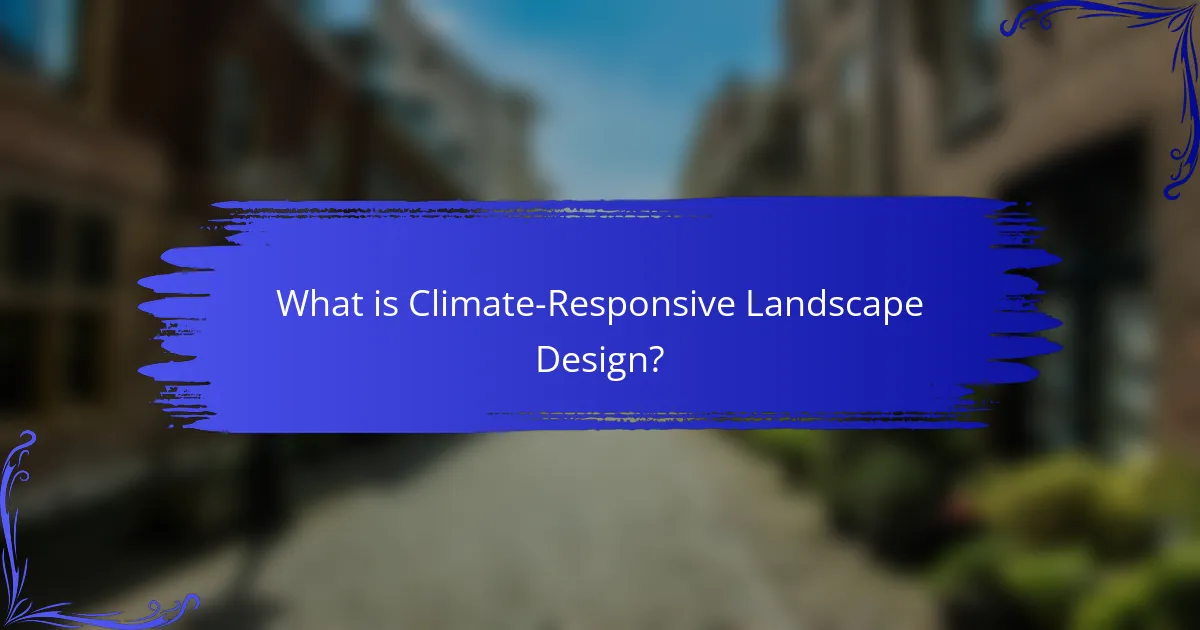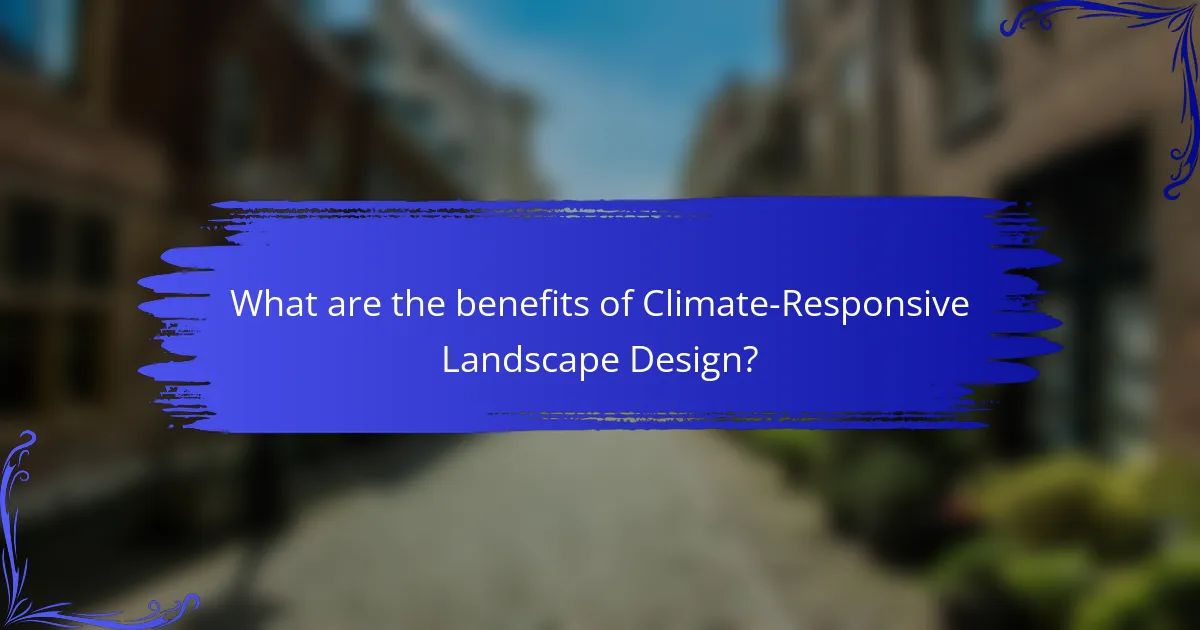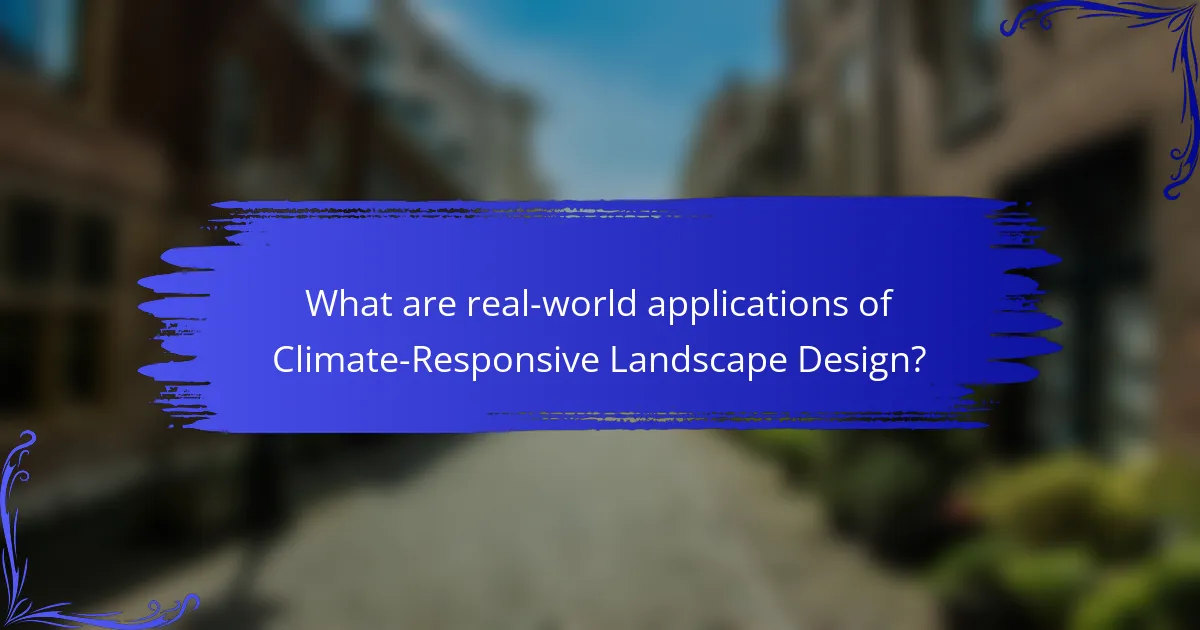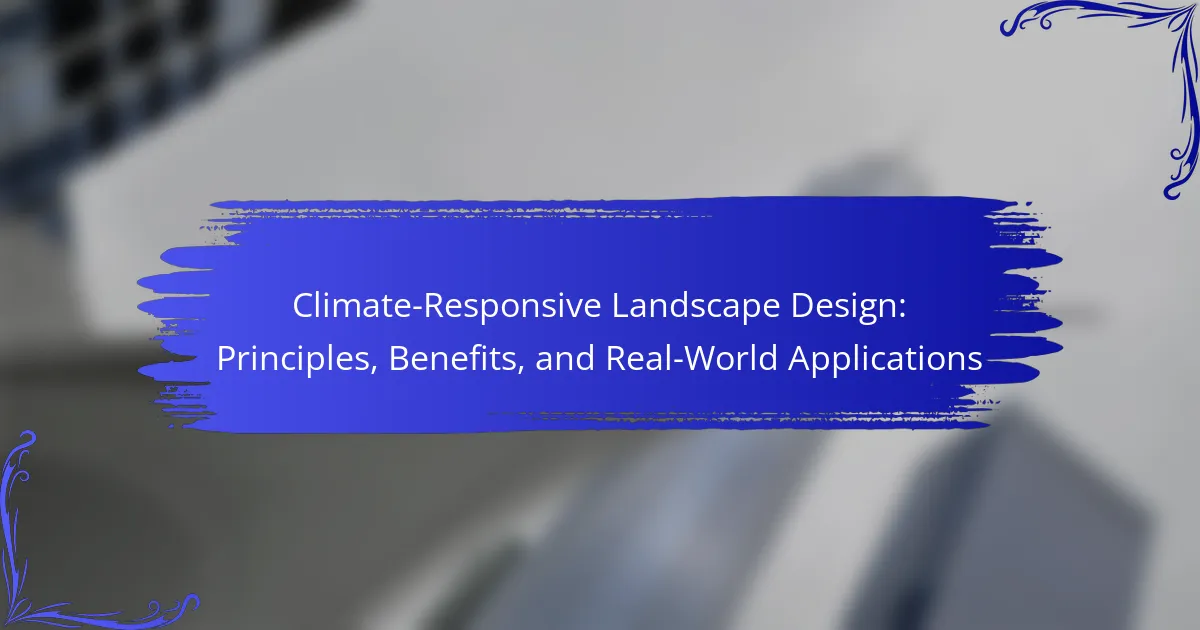Climate-responsive landscape design is an approach that adapts outdoor spaces to local climate conditions, enhancing ecological balance and resilience against climate change. This design method utilizes native plants, sustainable materials, and efficient water management while considering solar orientation and wind patterns. Key benefits include improved biodiversity, effective water management, reduced urban heat, and lower energy costs through natural cooling. Climate-responsive landscape design is applicable in urban planning, agriculture, and ecological restoration, demonstrating its effectiveness in addressing environmental challenges and promoting sustainable practices.

What is Climate-Responsive Landscape Design?
Climate-responsive landscape design is an approach that adapts outdoor spaces to local climate conditions. It aims to enhance ecological balance and resilience against climate change. This design method incorporates native plants, sustainable materials, and efficient water management. It also considers factors like solar orientation and wind patterns. By doing so, it minimizes resource consumption and promotes biodiversity. Research indicates that these designs can significantly reduce energy usage in buildings. Studies show that landscapes designed with climate responsiveness can improve urban heat mitigation.
How does Climate-Responsive Landscape Design differ from traditional landscape design?
Climate-Responsive Landscape Design prioritizes ecological sustainability, while traditional landscape design often focuses on aesthetics. Climate-Responsive approaches consider local climate conditions, biodiversity, and resource conservation. This design method uses native plants that require less water and maintenance. In contrast, traditional designs may rely on non-native species that need more resources. Climate-Responsive practices also incorporate water management techniques to mitigate flooding and conserve water. Traditional designs typically lack such integrated environmental strategies. Research shows that Climate-Responsive Design can reduce urban heat and improve air quality, providing tangible benefits.
What are the key principles of Climate-Responsive Landscape Design?
The key principles of Climate-Responsive Landscape Design include sustainability, adaptability, and ecological integration. Sustainability focuses on using resources efficiently to minimize environmental impact. Adaptability ensures designs can respond to changing climate conditions over time. Ecological integration involves incorporating native plants and habitats to support local biodiversity. These principles guide the creation of landscapes that are resilient and functional in the face of climate change. Research shows that implementing these principles can significantly reduce energy consumption and enhance ecosystem services. For example, studies indicate that green roofs can lower urban temperatures and improve air quality.
How does climate influence design choices in this approach?
Climate directly influences design choices in climate-responsive landscape design. Designers consider local climate conditions to enhance sustainability. For example, they select plant species that thrive in specific temperature ranges. This reduces water usage and maintenance needs. Additionally, climate data informs the placement of structures for optimal sun and wind exposure. Proper orientation can improve energy efficiency in buildings. Rainfall patterns also dictate drainage solutions and soil management strategies. These choices lead to resilient landscapes that adapt to changing environmental conditions.
Why is Climate-Responsive Landscape Design important?
Climate-responsive landscape design is important because it addresses environmental challenges. It helps mitigate climate change impacts by optimizing water use and enhancing biodiversity. This design approach promotes sustainable practices, reducing energy consumption in landscapes. Research indicates that such designs can lower urban heat islands by up to 5 degrees Fahrenheit. Additionally, they improve air quality and reduce stormwater runoff. Implementing climate-responsive strategies can lead to cost savings in maintenance and resource management. Overall, it fosters resilience in ecosystems and communities facing climate variability.
What environmental challenges does it address?
Climate-responsive landscape design addresses several environmental challenges, including climate change, biodiversity loss, and water scarcity. This approach mitigates climate change by reducing greenhouse gas emissions through sustainable practices. It enhances biodiversity by creating habitats for various species, thus promoting ecological balance. Additionally, it addresses water scarcity by implementing efficient water management techniques, such as rainwater harvesting and drought-resistant plant selection. These strategies help to conserve water resources and ensure sustainable landscapes.
How does it contribute to sustainability and resilience?
Climate-responsive landscape design contributes to sustainability and resilience by optimizing resource use and enhancing ecosystem services. It minimizes water consumption through drought-tolerant plant selection and efficient irrigation systems. This design approach improves soil health by incorporating organic materials and promoting biodiversity. It also reduces urban heat islands by increasing vegetation cover, which lowers energy consumption for cooling. Furthermore, it supports wildlife habitats, fostering ecological balance. Studies show that well-designed landscapes can reduce stormwater runoff by up to 65%, mitigating flood risks. Overall, climate-responsive landscape design plays a critical role in creating sustainable and resilient communities.

What are the benefits of Climate-Responsive Landscape Design?
Climate-responsive landscape design offers multiple benefits. It enhances local biodiversity by creating habitats for various species. This design approach also improves water management through efficient drainage and irrigation systems. Additionally, it reduces urban heat by incorporating vegetation that cools the environment. Climate-responsive landscapes can lower energy costs by minimizing the need for artificial heating and cooling. They also promote sustainable practices by using native plants that require less maintenance. Furthermore, these designs can increase property values by enhancing aesthetic appeal. Studies indicate that well-designed landscapes can improve mental health and well-being by providing green spaces for recreation and relaxation.
How does it enhance biodiversity?
Climate-responsive landscape design enhances biodiversity by creating habitats that support diverse species. This design approach incorporates native plants, which are essential for local wildlife. Native plants provide food and shelter for various insects, birds, and mammals. Additionally, these landscapes often include water features that attract aquatic species. The integration of different plant layers promotes ecological interactions. Research shows that diverse plant communities improve soil health and resilience. For example, studies indicate that biodiverse ecosystems are more productive and stable. This stability helps to maintain ecological balance and reduces vulnerability to pests and diseases.
What specific practices promote wildlife habitats?
Specific practices that promote wildlife habitats include creating native plant gardens. Native plants provide food and shelter for local wildlife. Incorporating water features supports aquatic species and increases biodiversity. Implementing wildlife corridors connects fragmented habitats, allowing safe animal movement. Reducing pesticide use enhances ecosystem health and protects beneficial insects. Establishing buffer zones around natural areas minimizes human impact. Implementing sustainable land management practices preserves soil health and water quality. These practices collectively support diverse wildlife populations and enhance ecological resilience.
How does it support ecosystem services?
Climate-responsive landscape design supports ecosystem services by enhancing biodiversity and improving soil health. This design approach integrates native plant species, which attract pollinators and other wildlife. It also promotes water conservation through strategic planting and irrigation methods. These practices reduce runoff and improve water quality. Additionally, climate-responsive landscapes can sequester carbon, thus mitigating climate change effects. Research shows that green spaces can lower urban temperatures and improve air quality. These benefits collectively contribute to healthier ecosystems and improved human well-being.
What economic advantages does Climate-Responsive Landscape Design provide?
Climate-Responsive Landscape Design offers significant economic advantages. It reduces maintenance costs by utilizing native plants that require less water and care. This design approach can lower energy costs by strategically placing vegetation to provide shade and wind protection. Increased property values are often observed in areas with well-designed landscapes. Studies indicate that properties with sustainable landscaping can see a 15% increase in value. Additionally, climate-responsive designs can enhance community resilience, reducing long-term costs associated with climate impacts. Overall, these economic benefits contribute to more sustainable and financially viable urban environments.
How does it reduce maintenance costs?
Climate-responsive landscape design reduces maintenance costs by utilizing native plants and sustainable practices. Native plants require less water and fertilizer, leading to lower upkeep expenses. These plants are adapted to local climates, resulting in reduced irrigation needs. Additionally, such designs often incorporate efficient drainage systems. This minimizes erosion and water pooling, which can lead to costly repairs. Research indicates that landscapes designed with climate responsiveness can cut maintenance costs by up to 50%. This efficiency not only saves money but also promotes environmental sustainability.
What impact does it have on property values?
Climate-responsive landscape design positively impacts property values. Properties with well-designed, sustainable landscapes often see increased market appeal. A study by the National Association of Realtors found that landscaping can increase property values by 10% to 15%. Additionally, homes in green neighborhoods tend to sell faster. Buyers are willing to pay more for energy-efficient landscaping features. These features can reduce utility costs, enhancing overall property attractiveness. Aesthetic appeal from thoughtful landscape design also contributes to higher valuations. Overall, climate-responsive landscapes create desirable living environments that enhance property worth.

What are real-world applications of Climate-Responsive Landscape Design?
Climate-responsive landscape design is applied in urban planning, agriculture, and ecological restoration. In urban areas, it enhances resilience to climate change by integrating green spaces that manage stormwater. For example, bioswales and green roofs reduce flooding and improve air quality. In agriculture, climate-responsive techniques promote sustainable practices such as permaculture and agroforestry. These methods increase biodiversity and soil health while conserving water. Ecological restoration projects utilize these designs to rehabilitate degraded landscapes, enhancing native habitats and carbon sequestration. These applications demonstrate the effectiveness of climate-responsive landscape design in addressing environmental challenges.
How is Climate-Responsive Landscape Design implemented in urban settings?
Climate-Responsive Landscape Design is implemented in urban settings through strategic planning and integration of natural elements. This approach focuses on enhancing biodiversity, managing stormwater, and reducing urban heat. Techniques include using native plant species that require less water and are more resilient to climate changes. Green roofs and walls are incorporated to improve insulation and reduce energy consumption. Urban parks and green corridors are designed to provide cooling effects and recreational spaces. Rain gardens and permeable pavements help manage runoff and improve water quality. These practices are supported by policies promoting sustainable urban development. Research shows that these designs can significantly lower urban temperatures and improve air quality.
What are some successful case studies in cities?
Successful case studies in cities include the High Line in New York City and the Cheonggyecheon Stream in Seoul. The High Line transformed an abandoned railway into a vibrant public park. It has increased local property values by 20% and attracted over 8 million visitors annually. Cheonggyecheon Stream revitalized a polluted waterway into a green corridor. This project reduced urban heat by 3 degrees Celsius and improved air quality significantly. Both examples demonstrate the benefits of climate-responsive landscape design in urban settings.
How does it integrate with urban infrastructure?
Climate-responsive landscape design integrates with urban infrastructure by enhancing ecological resilience and promoting sustainability. It utilizes green roofs, permeable pavements, and urban forests to manage stormwater effectively. These elements reduce urban heat and improve air quality. Studies show that integrating green spaces can lower city temperatures by up to 5°F. Moreover, this design approach supports biodiversity by providing habitats for wildlife. It also encourages community engagement through accessible green areas. The integration of climate-responsive design aligns with urban planning goals, promoting a healthier urban environment.
What role does Climate-Responsive Landscape Design play in agricultural practices?
Climate-Responsive Landscape Design enhances agricultural practices by optimizing resource use and improving resilience to climate change. It integrates ecological principles into farming, promoting sustainable land management. This design approach considers local climate, soil, and water availability. It encourages the use of native plants and efficient irrigation systems. Research shows that such practices can increase crop yields by 20-30%. Additionally, they help reduce soil erosion and enhance biodiversity. Evidence from various studies indicates that climate-responsive strategies lead to more sustainable farming outcomes.
How do farmers utilize these principles for sustainable farming?
Farmers utilize climate-responsive principles for sustainable farming by implementing practices that enhance soil health and conserve resources. They apply crop rotation to improve soil fertility and reduce pest cycles. Cover cropping is used to prevent soil erosion and enhance organic matter. Integrated pest management minimizes chemical use while maintaining crop yields. Agroforestry combines trees with crops to improve biodiversity and microclimates. These methods contribute to sustainable farming by reducing reliance on synthetic inputs and promoting ecological balance. Studies show that these practices can increase resilience to climate variability and enhance productivity over time.
What are the benefits for soil health and water management?
Soil health and water management provide critical benefits for sustainable agriculture and ecosystem resilience. Healthy soil enhances nutrient availability and supports plant growth. It improves soil structure, allowing better water infiltration and retention. This reduces erosion and runoff, promoting cleaner water sources. Effective water management conserves resources and mitigates flooding risks. It also supports biodiversity by creating habitats for various organisms. Research indicates that practices like cover cropping and mulching can significantly improve both soil health and water retention. These practices lead to increased crop yields and reduced irrigation needs.
What are some best practices for implementing Climate-Responsive Landscape Design?
Best practices for implementing Climate-Responsive Landscape Design include selecting native plants that require less water. These plants are adapted to local climates and can thrive with minimal maintenance. Incorporating permeable surfaces helps manage stormwater and reduce runoff. Designing for microclimates allows for the optimization of sunlight and shade. Utilizing rainwater harvesting systems can enhance irrigation efficiency. Implementing green roofs and walls improves insulation and reduces heat absorption. Lastly, engaging in community involvement fosters a sense of ownership and promotes sustainable practices. These strategies collectively contribute to resilient landscapes that adapt to climate challenges.
What steps should designers take when starting a project?
Designers should begin a project by defining the project goals and objectives. This establishes a clear direction for the design process. Next, they should conduct thorough research on the site and its context. Understanding the environmental factors is crucial for climate-responsive design. Designers must also identify the target audience and stakeholders involved. This ensures that the design meets the needs of those who will use the space. After gathering this information, designers should brainstorm and sketch initial concepts. This allows for creative exploration of ideas. Finally, they should develop a project timeline and budget. This helps in managing resources effectively throughout the design process.
How can communities participate in Climate-Responsive initiatives?
Communities can participate in Climate-Responsive initiatives through various actions. They can engage in local tree planting programs to enhance carbon sequestration. Community gardens can promote biodiversity and sustainable food sources. Educational workshops can raise awareness about climate change impacts and solutions. Local governments can involve residents in decision-making processes regarding land use and environmental policies. Collaborative projects can be established to restore natural habitats. Residents can adopt sustainable practices such as rainwater harvesting and energy conservation. Research shows that community involvement in such initiatives leads to more resilient ecosystems and improved local climate adaptation strategies.
Climate-Responsive Landscape Design is an adaptive approach that modifies outdoor spaces to align with local climate conditions, enhancing ecological balance and resilience against climate change. The article examines key principles such as sustainability, adaptability, and ecological integration, differentiating this design method from traditional landscape practices. It highlights the importance of native plants, efficient water management, and the benefits of improved biodiversity, reduced energy consumption, and enhanced property values. Additionally, it explores real-world applications in urban planning and agriculture, showcasing successful case studies and best practices for community involvement in climate-responsive initiatives.
